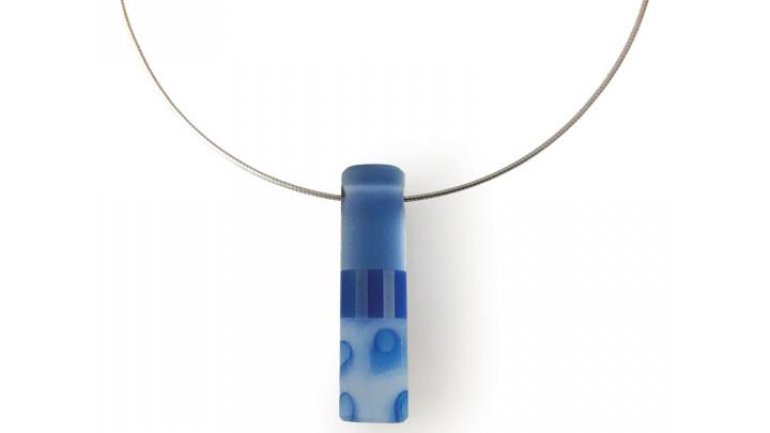Supercooled
Supercooled
It’s easy to be enchanted by the sleek, modernist charm of the patterned bowls and jewelry created by Supercooled, the husband-and-wife team of Eric Cruze and Tomo Sakai. They draw on a revered legacy: The pair’s exquisite creations are inspired by, among others, architect Carlo Scarpa, whose designs for Venini, the famed glass factory in Murano, Italy, shared a similar technique.
Yet the duo’s stylish designs are uniquely their own – and though their wares may come across as effortless, the process behind them is time-consuming and manifold. To make a murrine bowl, for example, Cruze and Sakai must pull glass they’ve patterned with color into solid rods ranging from 5 to 30 feet long. Then the rods are chopped into murrine, or canes, that are fused in the kiln before being slumped into a ceramic mold. Finally, the pieces head to the cold shop, where they undergo a series of finishing techniques. Although they make them in sets to work as efficiently as possible, it still takes the couple about six hours to complete one bowl.
It’s labor-intensive, but the process captivates them. “What fascinates us about murrine and cane pieces is that the surface and structure are integral,” Cruze says. Colorful organic patterns develop as the pieces melt and fuse to form the object’s surface, resulting in “a record of the flow of glass at high temperature.”
Sakai, who was born in Japan, was a glass-lover from the start. She completed her undergraduate studies in art and glass at Tama Art University in Tokyo in 2002. Cruze began his career as an architect. He earned his bachelor’s in 1989 and spent three years in the field but grew disenchanted. “As an architect, I felt limited by the complexity of the building process, as well as the difficulty of creating work with real craftsmanship,” he says. “I happened to take a glass workshop in Corning, New York, and realized I could pursue my passion for design through craft.” He moved on to study glass at the Appalachian Center for Craft in Tennessee. Meanwhile, Sakai headed to Europe to continue her studies. In 2005, fate brought the two together in Kamenický Šenov, Czech Republic, where they each completed residencies.
After marrying and working in Japan, the couple returned to the US in 2011, settling in Worcester, Massachusetts. Soon after, both began residencies at Worcester Center for Crafts; in 2014, they founded Cruze+Sakai studio, with a focus on installation and one-of-a-kind sculptural work. In 2016, the duo started Supercooled to add functional tableware and jewelry to their repertoire, then immediately hit the craft show circuit to make connections with shops and galleries.
Currently, the pair is working on a new series of sushi platters they call Hira, which double as wall art when not in use. Sakai is also exploring new jewelry designs that merge her traditional training in engraving and cutting with lamination and 3D-printing techniques.
No matter the project, Cruze and Sakai’s passion for the medium is unwavering. “Glass continually inspires us,” Sakai says, “even though it can be a challenging, fragile, and unforgiving material.”
A Slice of Life
Double take: If Cruze and Sakai’s designs remind you of biological patterns, you’re not alone; many scientists and engineers have approached them at shows, asking about the cellular patterns in their work.
In bloom: Sakai got a chance to combine her knowledge of ikebana, the Japanese art of flower arranging, with her glass skills through an ArtsWorcester grant. The cast-glass vases she created were on view in September.
One-stop shop: Cruze and Sakai not only complete each step of their glasswork – including making the molds – they also do their own photography and manage their social media, website, and graphic design.
Work by Cruze+Sakai is on view as part of “Recurrent Rhythms” at Morgan Contemporary Glass Gallery, October 6 - January 28.

